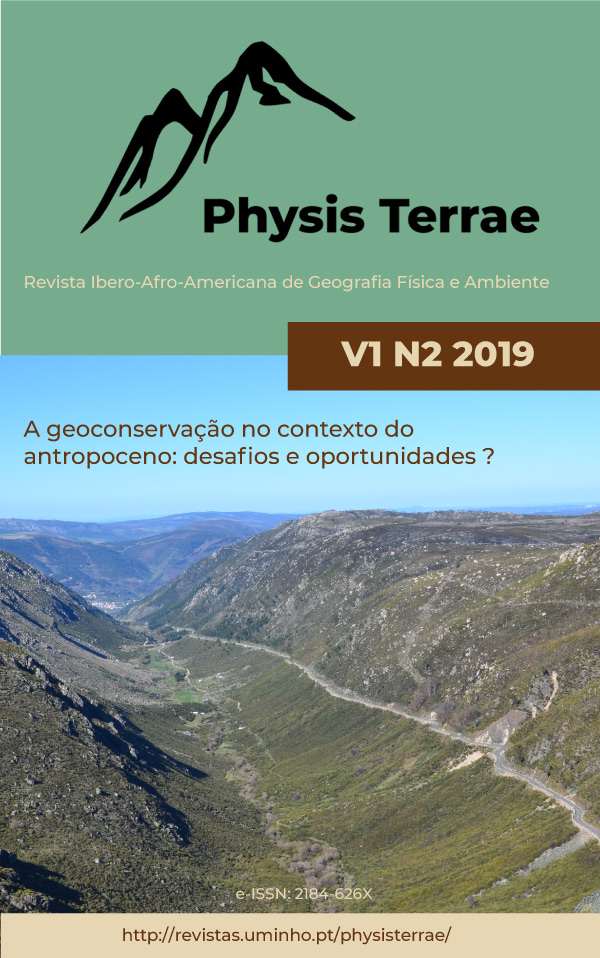Rapid impact assessment on touristic caves of Terra Ronca State Park, Goiás, Brazil
DOI:
https://doi.org/10.21814/physisterrae.2178Keywords:
Geoconservation, Protected areas, Tourism impacts, KarstAbstract
Terra Ronca State Park is located in the municipalities of São Domingos and Guarani de Goiás. The tourist motivation in the region is related to geotourism, especially with the visit to the caves. Karst environments have their own dynamics, which create unique environments. Aiming at the conservation of these environments, environmental diagnostic tools are employed focusing on the existing impacts in the area. The research occurred in 4 caves of Terra Ronca State Park, and an impact assessment protocol was applied, developed by Donato et al. (2014), to diagnose the situation of caves open to tourism in the park, reaching the following impact values: São Mateus - 21, São Bernardo - 29, Terra Ronca II - 34 and Terra Ronca - 40. The results showed that the caves are at risk and susceptible to several impacts, requiring urgent measures for the conservation of the environments associated with them. Implementation of the specific management plan for each cave is urgent, as this document is fundamental to guide the management and monitoring actions of the caves in question. It is important to highlight that in addition to such initiatives it is necessary to establish parallel programs of education and diffusion of the importance of these geosystems, providing knowledge of the general society about caves and their conservation.
Downloads
References
Cigna, A. A. (2011). Show Cave Development with Special References to Active Caves. Tourism and Karst Areas, 4(1), 7-16. Disponível em: http://www.cavernas.org.br/ptpc/tka_v4_n1_007-016.pdf
Donato, C. R. (2011). Análise de impacto sobre as cavernas e seu entorno no município de Laranjeiras, Sergipe. Dissertação de Mestrado em Desenvolvimento e Meio Ambiente, Universidade Federal de Sergipe, São Cristovão.
Donato, C. R., Ribeiro, A. S., Souto, L. S. (2014). A conservation status index, as an auxiliary tool for the management of cave environments. International Journal of Speleology, 43(3), 315-322. http://dx.doi.org/10.5038/1827-806X.43.3.8
Dowling, R. K. (2010). Geotourism’s Global Growth. Geoheritage, 3(1), 1-13. https://doi.org/10.1007/s12371-010-0024-7
Guerra, A. T., Guerra, A. J. (2015). Novo Dicionário Geológico-Geomorfológico. Rio de Janeiro: Bertrand Brasil.
Gray, M. (2013). Geodiversity and the Ecosystem Approach: The Contribution of Geoscience in Delivering Integrated Environmental Management. Proceedings of Geologists Association, 124(4), 659-673. https://doi.org/10.1016/j.pgeola.2013.01.003
Hardt, R. (2008) Sistema cárstico e impactos antrópicos: Considerações sobre o manejo. In: 1° SIMPGEO/SP, Rio Claro.
Hobo, F. E. (2011). Viajando por paisagens naturais: a espeleologia como experiência turística. Dissertação de mestrado em Geografia Física, Universidade de São Paulo, São Paulo.
Lobo, H. A. S., Boggiani, P., Sayeg, I. J., Perinotto, A. J. (2015). Impactos ambientais em espeleotemas causados pela visitação pública com carbureteiras na Caverna Santana (Parque Estadual Turístico do Alto Ribeira, Iporanga-SP). Geociências, 34(1), 103-115. http://www.ppegeo.igc.usp.br/index.php/GEOSP/article/view/8494
Lobo, H. A. S., Boggiani, P. (2013). Cavernas como patrimônio geológico. Boletim Paranaense de Geociências, 70, 190-199. http://dx.doi.org/10.5380/geo.v70i0.31698
Marra, R. J. C. (2001). Espeleo Turismo: Planejamento e Manejo de Cavernas. Brasília: Editora WD Ambiental.
Parks, K. E., Mulligan, M. (2010). On The Relationship Between a Resource based Measure of Geodiversity and Broad Scale Biodiversity Patterns. Biodiversity Conservation, 19, 2751-2766. https://doi.org/10.1007/s10531-010-9876-z
Rodrigues, M. L. (2009). Geodiversidade, Património Geomorfológico e Geoturismo. TERRiTUR, Rel. 1, GEOPAGE, CEG, IGOT-UL.
Simões, L. B. (2013). Biodiversidade da Fauna Subterrânea na Área Cárstica de São Domingos, Nordeste de Goiás: Relevância Versus Visibilidade. Dissertação, Universidade Federal de São Carlos, São Carlos.
Zanatto, V. G., Steinke, V. A., Vieira, A. A. B. (2019). Impactos do Geoturismo na Caverna Terra Ronca, Goiás, Brasil. Revista de Geografia e Ordenamento do Território, 16, 391-414. http://dx.doi.org/10.17127/got/2019.16.017


